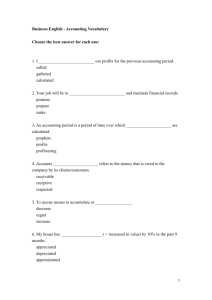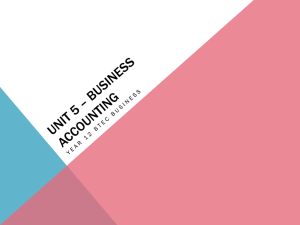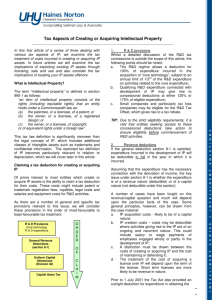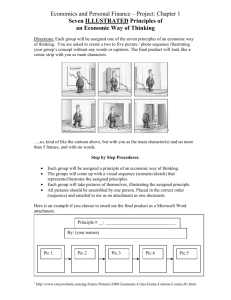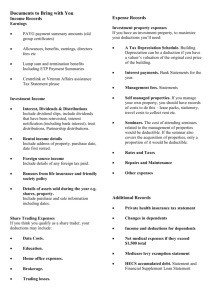here
advertisement
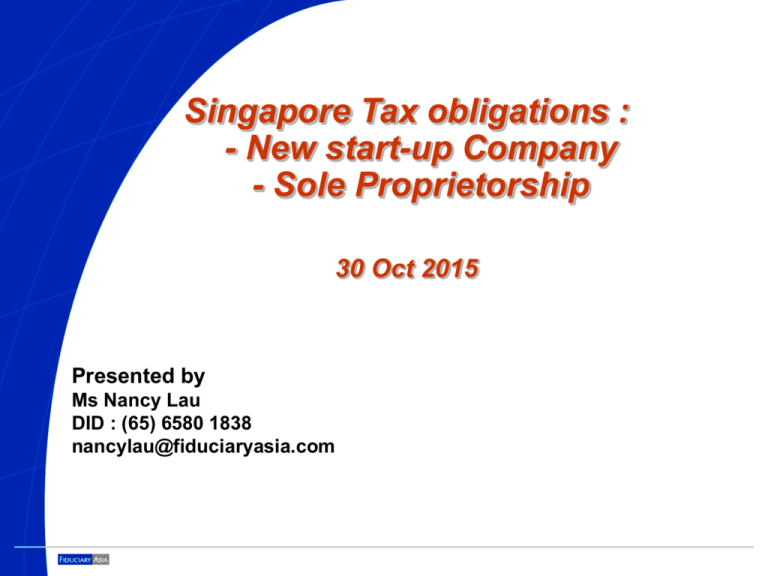
Singapore Tax obligations : - New start-up Company - Sole Proprietorship 30 Oct 2015 Presented by Ms Nancy Lau DID : (65) 6580 1838 nancylau@fiduciaryasia.com Agenda A. Basis of Assessment and Tax Obligation i. Sole-proprietorship (self-employ person) ii. Company (Pte. Ltd.) B. Taxable income & Deductions against Income C. Capital Allowance (CA) D. Productivity and Innovation Credit (PIC) E. Late Filing or Non-Filing of Tax Returns (A) Basis of Assessment Income is assessable on a preceding financial year basis Year of Assessment (YA) • year in which income tax is charged • current YA is YA 2015 (for income earn in year 2014) Basis Period for a YA the period of income relevant to the YA e.g. 1 Jan 2014 to 31 Dec 2014 (YA 2015) 1 Oct 2013 to 30 Sep 2014 (YA 2015) 1 Jul 2014 to 30 Jun 2015 (YA 2016) (A) Tax Obligation i. Sole-proprietorship A self employed person is - a person who carries on a trade, business, profession, or vocation. A self-employed can be operating as a: - Sole-proprietor - Partner of a partnership business (Normal partnership, Limited Liability Partnership, Limited Partnership (A) Tax Obligation i. Sole-proprietorship • File your Income Tax Returns (Form B) & make compulsory Medisave contributions • If you are a Precedent Partner of a partnership, you need to file Form P in addition to Form B • Comply with Income Tax Law requirements: Keep a proper record & accounts of your business for 5 years Report a complete & accurate set of business income in your Tax Returns (A) Tax Obligation i. Sole-proprietorship (individual) Filing Modes & Due Date - Paper File Form B (15 April) - e-File Form B (18 April) Report business income under “Sole-Proprietorship” in the “Trade, Business, Profession or Vocation” section of Form B as follows : Revenue Gross Profit / Loss; Allowable business expenses & Adjusted profit / loss (A) Tax Obligation ii. Company (Pte. Ltd.) 2 tax filing obligations: Estimate Chargeable Income When ? – within 3 months after end of accounting period Income Tax Return (Form C/ C-S) When ? – By 30 November of each year (A) Tax Obligation ii. Company (Pte. Ltd.) • Corporate Tax Rates is 17% • Tax Exemption Schemes Partial tax exemption for companies Chargeable income % exempted from Tax Amount exempted from Tax Tax exemption scheme for new start-up companies* Chargeable income % exempted from Tax Amount exempted from Tax First $10,000 @75% =$7,500 First $100,000 @100% =$100,000 Next $290,000 @50% =$145,000 Next $200,000 @50% =$100,000 =$152,500 Total $300,000 Total $300,000 * The exemption is available only for the first three YAs. =$200,000 (B) Taxable income & Deductions against Income a) Income tax is payable on: Income accruing in or derived from Singapore (i.e. income sourced in Singapore) Income received in Singapore from outside Singapore (i.e. foreign income received in Singapore) E.g. Trade income of a company carrying on business in Singapore E.g. Interest income from a foreign bank outside Singapore that is remitted to Singapore b) Deductions against Income • • • • Deductions allowed for expenses wholly and exclusively incurred in the production of income Expenses must be revenue in nature (e.g. normal day-to-day operating expenses Expenses must be incurred (i.e. not contingent liability or estimated amount) Deduction must not be prohibited under the Income Tax Act (e.g. private plated car expenses even if incurred for business purposes) (B) Taxable income & Deductions against Income Examples of Non-deductible Expenses Private and Domestic Expenses Capital Expenditure Claim of Estimated Purchases or Expenses Unreasonable Claim of Remuneration to Related Parties (e.g. Family members of director) • • Not incurred for business E.g. Directors’ private expenses on entertainment or vacation • E.g. Expenses incurred in acquiring capital assets or expenses to incorporate a company • Required to make claims based on actual amounts incurred, with supporting receipts/invoices • • Related parties do not work in company Payments do not commensurate with level of services performed To be deductible, payments must be reasonable having regard to similar services performed by an independent Employee • (B) Taxable income & Deductions against Income Deduction for Expenditure Incurred on Renovation or Refurbishment (R&R) Works under Section 14Q • Granted over 3 consecutive years on a straight-line basis so long as company continues to carry on that trade for which the R&R costs were incurred • Subject to an expenditure cap of $300,000* for every relevant threeyear period • Granted separately from the capital allowance framework for plant & machinery • Examples of qualifying expenditure (if they do not affect structure of the business premises) • • • • General electrical installation and lighting Kitchen and sanitary fittings Door and window Fixed partition • • • • Wall covering Flooring False ceiling and cornice More examples are available at IRAS’ website iras.gov.sg (B) Taxable income & Deductions against Income Deduction for Expenditure Incurred on Renovation or Refurbishment (R&R) Works under Section 14Q • Excludes expenditure relating to structural changes made to business premises and any: a) design fees or professional fees b) Antique c) any type of fine arts d) any works carried out in relation to a place of residence provided or to be provided to the company’s employees (applies to expenditure incurred from 18 Dec 2012) • Deduction against income => Forms part of adjusted loss – Available for carry forward & carry back – Prior to YA 2013, unutilised S14Q deduction is not allowed – to be transferred under group relief system (C) Capital Allowance • • • • Capital allowances given in place of depreciation and other capital expenditure, which are not tax-deductible Given on qualifying fixed assets bought and used for trade purposes Not part of setting or part of premises in which business is carried on (e.g. renovation expenditure => Does not qualify for capital allowance) Examples of qualifying fixed assets: • • • • • Carpet Electrical and electronic equipment (e.g. air-conditioning system, security/alarm system, sprinkler system and electrical appliances) Furniture and fixtures Industrial plant and machinery Motorcycle and bicycle • • • • Motor vehicle (goods /commercial vehicle such as lorry, truck and van) – Except Splate Movable partition Office equipment (e.g. computer, printer, photocopier, fax machine and telecommunication equipment) Venetian blind and curtain (C) Capital Allowance How to calculate Qualifying assets Annual allowance (AA) Over working life of asset • • Apply to all qualifying assets • [Section 19] 3-year write-off Initial allowance (IA) = 20% of cost AA = (80% of cost) / No. of years of working life Apply to all qualifying assets AA = 1/3 of cost • • AA = 100% of cost [Section 19A(1)] 1-year write-off (for specific assets) [Section 19A(2)] 1-year write-off (only for lowvalue assets) [Section 19A(10)] Computers Prescribed automation equipment listed in Income Tax (Automation Equipment) Rules 2004; and Amendment Rules 2010 (effective from 15 Dec 2010) Low-value assets • Cost of each asset not more than $5,000* • Total claim for 1-year write-off of all such assets capped at $30,000 per YA * Before YA 2013, it was $1,000 AA = 100% of cost (D) Productivity and Innovation Credit (PIC) i. Overview - 6 activities covered under scheme: • • • • • • Purchase/Leasing of PIC IT and Automation Equipment Training of Employees Acquisition/Licensing of Intellectual Property Registration of Intellectual Property Research & Development Approved Design Project ii. Tax Benefits under PIC Years of Assessment (“YA”) 2011 to 2018 400% tax deductions /allowances 400% tax deductions/ allowances on expenditure on each of the 6 activities for financial years 2010 to 2017 2013 to 2015 Cash payout PIC Bonus (Expire in YA 2015*) Opt for cash payout in place of tax deductions/ allowances for financial years 2010 to 2017 Dollar for dollar matching on qualifying expenditure, subject to the cap of $15,000 over the 3-year period (D) Productivity and Innovation Credit (PIC) (ii) Tax Benefits under PIC 400% tax deductions/allowances on up to $400,000 expenditure per year in each of the 6 activities To allow max PIC benefits, the spending cap across YAs for each activity is as shown below: Years of Assessment Expenditure Cap per Activity Tax Deduction per Activity 2011 and 2012 (Combined) $800,000 $3,200,000 (400% x $800,000) 2013 to 2015 (Combined) $1,200,000 $4,800,000 (400% x $1,200,000) 2016 to 2018 (Combined) $1,200,000 $4,800,000 (400% x $1,200,000) Note: Expenditure is net of grant or subsidy by the government or statutory board Expenditure exceeding the cap can still enjoy deduction based on existing rules (D) Productivity and Innovation Credit (PIC) (ii) Tax Benefits under PIC • Cash Payout Option – Option to convert expenditure of up to $100,000 in all 6 activities per YA – At 30% (YAs 2011 and 2012) / 60% (YAs 2013 to 2018) cash payout rate $100,000 Expenditure incurred during the basis period for YA 2015 60% $60 000 Cash Payout for YA 2015 – Expenditure converted is not tax deductible – Cash payout is non-taxable – Conditions to apply: • Employed at least 3 local employees* (Singapore Citizens or PRs with CPF contributions) in the last 3 months of the quarter or combined quarters in the basis period for the relevant YA • Carrying on business operations in Singapore – PIC cash payout application form submit must after the end of each quarter or combined quarters in the financial year but not later than the income tax filing due date (D) Productivity and Innovation Credit (PIC) (ii) Tax Benefits under PIC Examples Current Automation Equipment in “PIC IT and Automation Equipment List" includes: Facsimile Optical character reader Automated kitchen equipment (for F&B industry only) Laser printer Mainframe/Computers Milling machines Interactive shopping carts Automated housekeeping Office system software Automatic storage and retrieval system of warehouses Automated seating systems for convention or exhibition centre Automotive navigation systems More examples are available at the IRAS website. (E) Late Filing or Non-Filing of Tax Returns Actions Taken for Late/Non-Filing: i. Sole-proprietorship (individual) • Issue an estimated Notice of Assessment; • Impose a late filing fee; • Summon the taxpayer to Court where the penalty can be twice the tax assessed by IRAS; • Issue a Warrant of Arrest. ii. Company (Pte. Ltd.) • Issue an estimated Notice of Assessment (NOA). The company is required to pay the tax amount based on this estimated NOA within one month; • Impose a penalty for not filing; • Issue a Section 65B(3) notice to the director followed by a summons to the director; and/ or • Summon the officer responsible for running of the company to Court. The penalty imposed could be twice the tax amount assessed FIDUCIARY ASIA TAX ADVISORS PTE LTD SOLUTION PROVIDER TAX AND STRUCTURES Thank You

